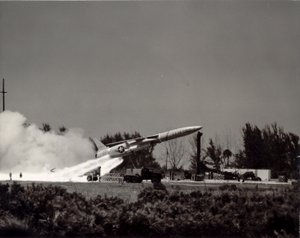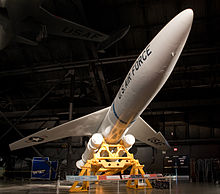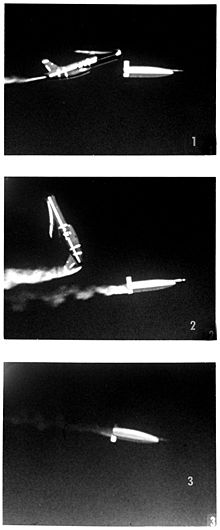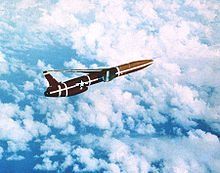- SM-62 Snark
-
Northrop SM-62 Snark 
Place of origin  United States
United StatesService history In service 1959-1961 Used by U.S. Air Force Production history Manufacturer Northrop Produced 1958-1961 Specifications Weight 48,147 lb (21,839 kg) without booster, 60,000 (27,200 kg) with booster Length 67 ft 2 in (20.47 m) Warhead W39 nuclear warhead (3.8 megatons) Engine 1× Pratt & Whitney J57 jet engine; 2 Aerojet-General solid-propellant rocket boosters
J-57: 10,500 lbf (46.7 kN) thrust, rockets: 130,000 lbf (580 kN) thrustWingspan 42 ft 3 in (12.88 m) Operational
range5,497 nm (10,180 km) Flight ceiling 50,250 ft (15,320 m) Speed 565 kn (1,050 km/h) Guidance
systemcelestial navigation Launch
platformMobile Launcher The Northrop SM-62 Snark was a specialized intercontinental cruise missile with a W39 nuclear warhead operated by the U.S. Strategic Air Command from 1958 until 1961. It takes its name from Lewis Carroll's snark.[1]
The Snark was developed to offer a nuclear deterrence to the Soviet Union at a time when ICBMs were still in development. It was the only intercontinental surface-to-surface cruise missile ever deployed by the United States Air Force. With the deployment of ICBMs, it was rendered obsolete and taken out of service.
Contents
Design and development
 Display at the National Museum of the United States Air Force
Display at the National Museum of the United States Air Force
Work on the project began in 1946. Initially there were two missiles — a subsonic design (the MX775A Snark) and a supersonic design (the MX775B Boojum).[2] Budget reductions threatened the project in its first year, but the intervention of Jack Northrop and Carl Spaatz saved the project. Despite this, funding was low and the program was dogged by requirement changes. The expected due date of 1953 passed with the design still in testing and SAC was becoming less enthusiastic. In 1955, Eisenhower ordered top priority to the ICBM and associated missile programs. The original designation was B-62.
Despite considerable difficulties with the missile and military reservations toward it, work continued. In the 1957 tests the missile had a circular error probable (CEP) of only 17 nautical miles (31.5 km). By 1958 the celestial navigation system used by the Snark allowed its most accurate test, which appeared to fall 4 nautical miles (7.4 km) short of the target. However, this apparent failure was at least partially because the British Navigation Charts used to determine the position of Ascension Island were based on position determination techniques less accurate than those used by the Snark. The missile landed where Ascension Island would be found if more accurate navigation methods had been used when developing the chart.[3] However, even with the decreased CEP, the design was notoriously unreliable, with the majority of tests suffering mechanical failure thousands of miles before reaching the target. Other factors, such as the reduction in operating altitude from 150,000 to 55,000 feet (46 to 17 km) and the inability of the system to detect countermeasures and perform evasive maneuvers also made the Snark an undesirable strategic deterrent.
Technical description
The jet powered 20.5 m long unmanned aircraft had a top speed of 650 mph (1,046 km/h) and a maximum range of 5,500 nautical miles (10,200 km). The complex stellar navigation guidance system gave a claimed CEP of 8,000 ft (2.4 km).
The Snark was an air-breathing design, launched from a light platform by two rocket booster engines. It switched to an internal jet engine for the remainder of its flight. The jet was a Pratt and Whitney J57, the first 10,000 lbf (44 kN) thrust design, also used in the early B-52 and the F-100. Lacking a horizontal tail, the missile used elevons as its primary flight control surfaces, and flew an unusual nose high aspect during level flight. During the final phase of flight the nuclear warhead separated from the missile's main body and followed a ballistic trajectory to the target. Upon separation, due to the abrupt shift in its center of gravity, the missile body performed an abrupt pitch-up maneuver to avoid colliding with the warhead.
One advanced feature of the Snark was its ability to fly missions of up to 11 hours and return for a landing. If the warhead did not detach, the missile could be flown repeatedly. Lacking landing gear, it was necessary for the Snark to skid to a stop on a flat, level surface. The runway at Cape Canaveral is still today known as the Skid Strip.
Operational history
In January 1958 the Strategic Air Command began accepting delivery of operational missiles to Patrick Air Force Base in Florida for training and in 1959 the 702d Strategic Missile Wing was formed. Multiple launch failures led to the Atlantic Ocean off Cape Canaveral being described as "Snark infested waters."
On 27 May 1959, Presque Isle Air Force Base in Maine, the only Snark base, received its first operational missile. Ten months later, on March 18, 1960, a Snark officially went on alert status. Thirty are known to have been deployed."[4]
The 702nd was not declared fully operational until February 1961. In March 1961, President Kennedy declared the Snark "obsolete and of marginal military value" and on 25 June 1961 the 702d was deactivated.[1]
Survivors
- Air Force Space & Missile Museum, Cape Canaveral Air Force Station, Florida
- National Museum of the United States Air Force, Wright-Patterson Air Force Base, Dayton, Ohio
- Hill Air Force Base, Ogden, Utah
- National Museum of Nuclear Science & History, Albuquerque, New Mexico
See also
- Aircraft of comparable role, configuration and era
- Related lists
References
- ^ The poem "The Hunting of the Snark".
- ^ From the same poem: "The snark was a boojum, you see."
- ^ "Personal interview with George F. Douglas, Chief Project Engineer, ca. 1967"
- ^ Gibson, James N. Nuclear Weapons of the United States — An Illustrated History . Atglen, Pennsylvania.: Schiffer Publishing Ltd., 1996, Library of Congress card no. 96-67282, ISBN 0-7643-0063-6, page 151.
External links
- The Evolution of the Cruise Missile by Werrell, Kenneth P.
- The Day They Lost The Snark by J.P. Anderson Air Force Magazine article about a Snark that was test-fired and rumored to have been found in Brazil
- Excellent article on the Snark on FAS.org
- Our First Guided Missileaires, July 1954, Popular Mechanics detailed article on Snark and the USAF school to train personnel for it
Northrop aircraft Manufacturer
designations'Greek' series'N' seriesNote: Northrop company designations include a wide variety of technologies. Only aircraft, aero engines, and missiles are linked here.
N-1 · N-2 · N-3 · N-4 · N-5 · N-6 · N-7 · N-8 · N-9 · N-10 · N-12 · N-14 · N-15 · N-16 · N-18 · N-19 · N-20 · N-21 · N-23 · N-24 · N-25 · N-26 · N-29 · N-31 · N-32 · N-34 · N-35 · N-36 · N-37 · N-38 · N-39 · N-40 · N-41 · N-46 · N-47 · N-48 · N-49 · N-50 · N-51 · N-52 · N-54 · N-55 · N-59 · N-60 · N-63 · N-65 · N-67 · N-68 · N-69 · N-71 · N-72 · N-73 · N-74 · N-77 · N-81 · N-82 · N-94 · N-96 · N-102 · N-103 · N-105 · N-110 · N-111 · N-112 · N-117 · N-124 · N-132 · N-133 · N-134 · N-135 · N-138 · N-141 · N-144 · N-149 · N-150 · N-151 · N-155 · N-156 · N-205 · N-267 · N-285 · N-300'P' seriesP530 · P600 · P610
By role AttackBombersDronesFightersReconnaissanceTrainersTransportsExperimentalNames Bantam · Black Bullet · Black Widow · Chukar · Nomad · Pioneer · Raider · Reporter · Scorpion · Snark · Talon · Tigershark
See also: TR-31955-1962 United States Air Force rocket and missile designationsAir-to-air missiles Other missiles - See also:
- Alpha Draco
- Bold Orion
- High Virgo
- Pye Wacket
- Sky Scorcher
- United States tri-service missile and drone designations post-1962
USAAS/USAAC/USAAF/USAF bomber designations 1924–1962 Bomber XB-1 · B-2 · B-3 · B-4 · B-5 · B-6 · Y1B-7 · XB-8 · YB-9 · B-10 · YB-11 · B-12 · XB-13 · XB-14 · XB-15 · XB-16 · B-17 · B-18 · XB-19 · Y1B-20 · XB-21 · XB-22 · B-23 · B-24 · B-25 · B-26 · XB-27 · XB-28 · B-29 · XB-30 · XB-31 · B-32 · XB-33 · B-34 · YB-35 · B-36 · B-37 · XB-38 · XB-39 · YB-40 · XB-41 · XB-42 · XB-43 · XB-44 · B-45 · XB-46 · B-47 · XB-48 · YB-49 · B-50 · XB-51 · B-52 · XB-53 · B-54 · XB-55 · XB-56 · B-57 · B-58 · XB-59 · YB-60 · B-61 · B-62 · B-63 · B-64 · B-65 · B-66 · B-67 · XB-68/SM-68 · RB-69 · XB-70 · SR-71
Light bomber Heavy bomber XHB-1 · XHB-2 · XHB-3
Long-range bomber 1947-1951 United States Air Force rocket and missile designationsAir-to-air missiles AAM-A-1 • AAM-A-2
Air-to-surface missiles ASM-A-1 • ASM-A-2
Surface-to-air missiles SAM-A-1
Surface-to-surface missiles Launch test vehicles LTV-A-1
Propulsion test vehicles Rocket test vehicles Types of missile By platform - Air-to-air missile (AAM)
- Air-to-surface missile (ASM)
- Surface-to-air missile (SAM)
- Surface-to-surface missile (SSM)
- Ballistic missile
- Intercontinental ballistic missile (ICBM)
- Submarine-launched ballistic missile (SLBM)
- Anti-ballistic missile (ABM)
- Intermediate-range ballistic missile (IRBM)
- Cruise missile
- Anti-ship missile (AShM)
- Anti-submarine missile
- Anti-tank missile (ATGM)
- Anti-satellite weapon (ASAT)
- Air-launched ballistic missile
- Anti-ship ballistic missile (ASBM)
By guidance Lists - List of missiles
- List of missiles by country
- List of military rockets
Categories:- Cold War missiles of the United States
- Nuclear cruise missiles of the United States Air Force
- Cold War cruise missiles
Wikimedia Foundation. 2010.


